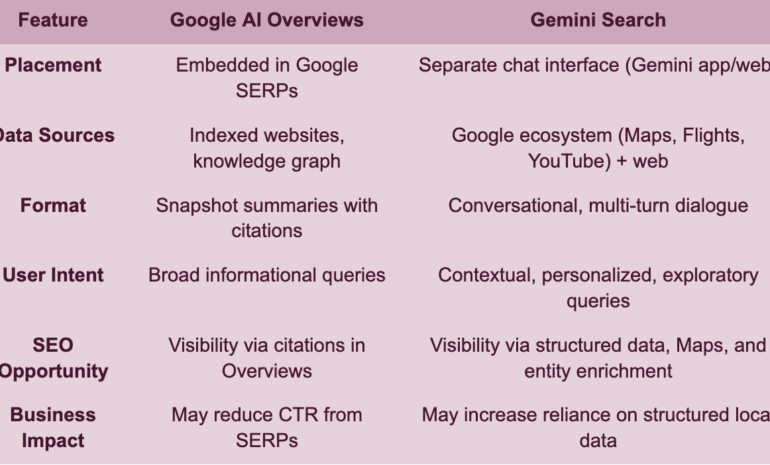For years, backlinks were the currency of SEO and still are…but the landscape around them is shifting rapidly. With AI-driven search engines like Gemini, Copilot, and ChatGPT pulling from structured data, local reviews, and on-page signals instead of just crawling for PageRank, many are wondering: Do backlinks still matter in the AI era?
Short answer: Yes.
Long answer: Yes, but not in the same way, and not across all verticals.
If you’re a SaaS SEO provider that works with multi-location brands to rank locally and convert organically, to understand how backlink strategy is evolving and how to manage it programmatically is critical to staying competitive in 2025.
SEO Isn’t Dead, It’s Just Fractured
There’s a misconception floating around that AI will kill SEO. That’s not true. What we’ can see instead is the fracturing of traditional SEO into multiple, specialized layers:
- Classic SEO: Still matters for Google’s blue links and local packs.
- AI SEO: Involves structuring data for AI agents, which don’t always rely on backlinks.
- Local SEO: Prioritizes proximity, citations, and structured data over traditional PageRank metrics.
Each layer values backlinks differently.
For SaaS platforms, this means offering backlink monitoring tools alone isn’t enough. You must help brands understand which type of visibility they’re targeting and align your strategy accordingly.
The Technical Role of Backlinks in 2025
Backlinks haven’t lost value, they’ve become context-dependent. Here’s how that breaks down:
When Backlinks Still Matter (Heavily)
- For informational content: Blogs, guides, and resources that still surface in organic SERPs.
- For authority signals: Especially for medical, legal, and financial industries.
- For off-page trust: Google continues to use backlinks as a measure of Experience, Expertise, Authority, and Trust.
When Backlinks Matter Less
- Local proximity queries: “Pizza near me” pulls from listings, not link profiles.
- Voice search and AI overviews: These increasingly pull from publisher feeds, structured data, and citations.
- AI chat results: Tools like Perplexity or Copilot may bypass backlink authority in favor of on-page clarity and structured facts.
So basically, the type of backlink and where it points (homepage vs. local page vs. review site) is now more important than sheer volume.
A Multi-Location Backlink Strategy That Works Now
SaaS SEO platforms that manage backlinks for multi-location brands need to offer a granular, location-aware, and adaptive approach. Here’s what that means in practice:
1. Track Backlinks by Location Page
Don’t lump everything into domain-level metrics. Use a backlink API or crawler to separate links pointing to /locations/chicago vs. /locations/dallas.
2. Monitor Relevance by Vertical + Region
Not all backlinks are created equal. A niche blog from a Chicago food influencer may be more valuable for a local pizzeria than a high-authority national publication.
3. Pair Backlinks with Engagement Metrics
Integrate data from GA4 or Matomo to measure what happens after the click. Are linked users bouncing? Are they converting?
4. Local Listings + Citations Count Too
Directory backlinks (think Yelp, GMB, Bing Places) are still a key ranking signal in local SEO. Automate listings checks to catch dropped links or outdated NAP (Name, Address, Phone).
5. Enable AI-Structured Content
Where AI is extracting answers (e.g., “best dentist in Boston”), make sure your local pages are optimized with:
- FAQ schema
- Local Business markup
- Owner responses to reviews
These elements don’t require backlinks but when combined with authoritative backlinks, they increase the chance of AI visibility + organic rankings.
Backlink Management Is Now API-First
Manual backlink audits don’t scale for brands with 500 or 5,000 locations. SaaS platforms must offer:
- Backlink monitoring APIs
- Citations verifications
- Anchor text distribution mapping
- Toxic backlink detection per location
- Automatic disavow file creation (when needed)
This shift mirrors what happened with listings: once manual, now automated. Backlink strategy must follow the same trajectory.
Why Backlinks Still Matter for Discovery and UX
Even as AI rewires the SEO landscape, backlinks continue to serve a critical role in user discovery, especially when they originate from relevant, high-trust sources. A well-placed backlink isn’t just about search engine signals, it’s a direct path for real people to find your business, often in a more qualified, contextually relevant way. Whether it’s a mention in a neighborhood blog, a local press piece, or a high-authority niche directory, backlinks act as endorsements that drive intent-heavy traffic.
For SaaS marketing platforms managing thousands of business locations, this creates opportunities to add value beyond rankings. By using a Listings API to ensure every business has up-to-date citations across key directories, and combining that with a Backlink API to surface earned media mentions and hyperlocal referral traffic, you create an integrated view of both visibility and credibility. These are easy wins when automated: detecting dropped links, auditing anchor text, and identifying backlinks to location-specific URLs can all be streamlined via API calls. The result? A scalable system that turns backlinks into real-world discovery tools, not just ranking levers.
The New KPIs for Multi-Location Backlink Success
Outdated:
- Domain Authority (DA)
- Total referring domains
Updated for 2025:
✅ % of backlinks to verified local pages
✅ CTR + bounce rate from linked content
✅ Backlink-driven conversions by region
✅ % of local listings with active citation backlinks
✅ AI snippet inclusion rates (with backlink attribution)
Backlinks are no longer about shouting the loudest but more about whispering to the right people, in the right city, on the right platform.
SaaS SEO providers who help multi-location brands succeed won’t abandon backlinks… they’ll evolve how they manage them. That means smarter APIs, more local granularity, and a focus on relevance over raw numbers.


